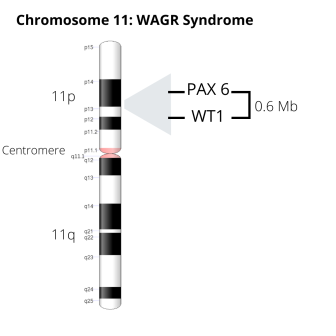"WAGR Syndrome Overview: Families and Researchers Working Together to Improve Clinical Outcomes"

WAGR syndrome is a rare genetic disorder, affecting approximately 1:1 million births. Males and females are equally affected. "WAGR" is an acronym for the cardinal features of the syndrome: Wilms tumor, Aniridia, Genitourinary abnormalities, and Range of developmental delays. Not all cases involve all of these features. Many associated conditions are possible, affecting a wide range of body systems.

WAGR syndrome is caused by heterozygous deletions of WT1 and PAX6 on chromosome 11p13. Size and position of the deletion varies between individuals, resulting in a range of phenotypes.
The first sign is usually Aniridia, a partial or near-complete absence of the iris. Male infants often have hypospadias and/or cryptorchidism. Internal genital anomalies may be present in females. Wilms tumor occurs in approximately 50 percent, most often between 1-3 years of age but has been reported up to age 19. Range of Developmental delay and intellectual disability ranges from mild to severe, with most in the mild to moderate range. A few individuals have normal or near-normal IQ.
Other conditions associated with WAGR syndrome include:
There is no cure for WAGR syndrome. However, children with this disorder benefit from early medical support and developmental interventions, including physical, occupation, and speech therapies. Special educational services are also beneficial. Life expectancy in WAGR syndrome has not been studied, but early detection and prompt treatment of potentially life-limiting conditions such as Wilms tumor and end stage renal failure can improve the long-term prognosis.
Infants with isolated Aniridia should be referred for genetic testing. Recommended genetic tests include:
Note standard metaphase karyotype (450-550 bands) alone may fail to detect some smaller-sized deletions. Lymphocyte high resolution chromosome analysis (550-800 bands) is sensitive to smaller deletions, but does not allow for identification of BDNF gene deletion, which is important to clinical management.
Duffy KA, Trout KL, Gunckle JM, Krantz SM, Morris J, Kalish JM. Results from the WAGR Syndrome Patient Registry: Characterization of WAGR Spectrum and Recommendations for Care Management, Frontiers in Pediatrics, December 2021
Printable Information for Healthcare Providers
From one-page information sheets to in-depth articles on specific conditions associated with WAGR syndrome
Medical and Scientific Advisory Board
The IWSA Medical and Scientific Advisory Board is composed of leaders in WAGR syndrome research and clinical practice who are committed to furthering the mission of the IWSA. This international team of dedicated professionals are central to the goals of advancing research and improving clinical management of WAGR syndrome.
WAGR Syndrome Patient Registry
The IWSA maintains a high-quality, online Patient Registry
Information, encouragement, and practical advice for parents of newly diagnosed patients
Helpful resources for parents of children/adults with WAGR syndrome
Sign up for News & Events
COPYRIGHT© 2025 IWSA / International WAGR Syndrome Association
